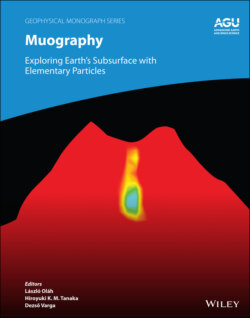Читать книгу Muography - Группа авторов - Страница 17
1.2.2 Geomagnetic Effects in the Muon Flux
ОглавлениеMuographic images are usually produced in the spherical coordinate system, and generally contain angular‐dependent background events that distort the images. In the following section, the possible sources of these backgrounds are examined. In the vicinity of Earth, due to positively charged primary GCRs and the geomagnetic field directed towards the geomagnetic North Pole, some eastern trajectories of the incoming cosmic rays are suppressed (East‐West effect). This geomagnetic cutoff is caused by the geomagnetic shielding that affects the charged cosmic rays arriving from outside the magnetosphere, and its threshold rigidities range from less than 109 V near the geomagnetic poles to about 1.6 × 1010 V for vertical particles near the equator (Smart & Shea, 1994). As a result, cosmic-ray muons from the east are found to have a weaker flux than those from the west. This East‐West geomagnetic effect is more pronounced at higher altitudes. In middle latitude regions at sea level, only primary GCRs having lower energies are more affected by the geomagnetic field, but they do not contribute to production of muons in the atmosphere. For this reason, there has been a long discussion about whether the East‐West effect is observable in the sea‐level muon flux (Hansen et al., 2005). The recent measurements with the Far detector used for the NOvA experiment showed the East‐West asymmetry of cosmic‐ray muons of ~1% (Petrova, 2019) within the zenith angular range between 30o and 70o at Ash River, MN, USA.
This East‐West geomagnetic effect strongly depends on the latitude where the cosmic‐ray muons are measured. First measured 70 years ago, the vertical flux of muons with momentum around 0.33 GeV/c at latitude 60° was 1.8 times higher with respect to the flux at the equator (Conversi, 1950). This latitudinal geomagnetic effect was more recently measured between the middle latitude region (the cutoff values of 2.7 × 109 V) and the region near the equator (the cutoff values of 1.4 × 1010 V), respectively, indicating variations by 20 and 10% in the flux of muons with energies of ~0.3 GeV/c and ~1 GeV/c and no significant variations could be seen in the muons above 3 GeV/c (Allkofer et al., 1975). In conclusion, this latitudinal effect is practically negligible in muography as long as the measurements are conducted within the mid‐latitude region. However, in the region near the equator, it can influence muons below ~5 GeV at sea level (Allkofer et al., 1975).
